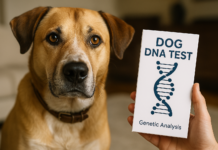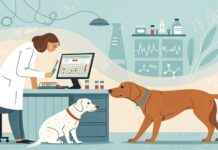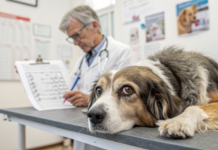Last Updated on March 11, 2022 by Dogs Vets
Most Common Dog Health Problems: Signs, Reasons, & Cures
Dog lover? Yes, me too! Dogs are the most preferred choice of around 70 to 80% of individuals when it comes to household pets. According to the 2021/22 pet owner’s survey, 69 million households in the United States owned at least one dog.
Dogs are one of the most affectionate and loyal creatures on earth.
There are many dog breeds gaining popularity today. When you’re getting prepared to bring a new canine home, you’re going to have to get a lot of supplies.
Well, it’s necessary, but there is one more thing that you should know. Yes, that’s pet health-related problems.
It is generally seen that we keep dogs but cannot take care of them. You’re primarily here thinking, “I feed him every day or play with them and many more.” Well, these things are basic needs but are these sufficient?
No, moreover you should be aware of their health problems. Unfortunately, health issues are a part of life in our pets, affecting the young, the elderly, and every age in between.
To help your canine friend lead a healthy life, you need to be aware of some of the most typical health problems dogs face, their signs, and what you can do about them.
6 Health Issues In Dogs, Their Signs And How To Help Them Deal With:
Arthritis:

Any dog can develop arthritis, but it is more common in older dogs and large breeds. But it is a long-term condition that needs life-long management. If you ignore its signs or do not detect it in the early stages, it gradually worsens over time. But if well managed, most dogs can live happily for many years after diagnosis.
Common Signs of Arthritis in Dogs:
- Changing behavior
- Tiredness
- Muscle Atrophy
- Yelping when Touch
- Lameness and nay more
Significant Reasons for Arthritis in Dogs:
- Ageing
- congenital joint disorders
- Diabetes
- Hip dysplasia
- Obesity
- Stress on Joints
Way To Help Your Dog Provide Comfort From Arthritis:
- Massage and Exercise
- Orthopedic dog beds for comfortable setting and sleep
- Consult vet from time to time
- Control weight and offer them a healthy diet with proper nutrition
Obesity:

60% of dogs are either overweight or obese. Did you know that obesity increases the dog’s risk of certain types of cancer, arthritis, diabetes, heart disease, and hypertension? Yes, it’s true. Untreated, these conditions could lead to a respiratory crisis which could be fatal if not treated.
Common Sign Dog Is Overweight:
- Fewer moves
- No play
- A reluctance to go for walks or to lag behind
- Big face
- Abdominal sagging
Causes To Be Overweight:
- Wrong Diet
- Too many calories
- Not enough exercise
Ways to Prevent Dog from Becoming Obese:
- Consult vet properly
- Choose appropriate diet
- Increase your dog’s walk and exercise time
- Limit treats and table scraps
Allergies:

Allergies in dogs of breeds and backgrounds are more common than food allergies. Allergies can’t be cured, but they are easily manageable.
Symptoms of Allergies in Dogs:
- Redness around eye
- Diarrhea
- Vomiting
- Sneezing
- Itchy ears and many more.
Ways to Protect a Dog from Allergies:
- Consider the whole environment
- Get medical help
- Add habit in their routine to sleep on clean chew proof dog beds only
- Groom properly
- Wash your dog paws after a quick walk
- Wash your dog as frequently as another week
Dental Disease:

This is a serious and often overlooked health concern for dogs. If you think bad breath in dogs is common, you are wrong. This is a sign of a dental problem.
Usually, you won’t notice any obvious signs or symptoms of this silent disease until it reaches its advanced stages. 80% of dogs will have some sign of dental disease by the age of two.
Symptoms of Dental diseases in Dogs
- Irritability
- Weight loss
- Bloody saliva
- Drop-In appetite
- Brown or yellow teeth
Dental disease in dogs is caused by a buildup of plaque and tartar on the teeth. And over time, it leads to gum infection, bone loss, loss of teeth, and other serious issues.
How to Keep Your Dog Mouth Healthy?
Diligent at-home dental care and regular dental checkups by your vet are the only ways to give your furry a healthy mouth. You can also chew bones and chew toys for more routine teeth cleanings.
Cataracts:

This is a significant health issue, especially for older dogs, as it can really affect the way they see. It is also known as vision impairment. If not taken care of or treated correctly, it even leads to blindness.
Symptoms of Cataracts in Dogs:
- Difficulty in seeing
- Redness in eyes
- Change in eye color
- Size and shape of the pupil
Causes of Cataracts in Dogs:
- Injury
- Diabetes
- Inherited disease
- Mellitus
How Do You Treat Cataracts In Dogs?
If you encounter any of the above-mentioned symptoms in a dog, you must consult with a vet. Or you can opt. for Coenzyme Q10. It is a potent antioxidant that can stop the progression of cataracts and strengthen the eye.
Hip Dysplasia:

Hip dysplasia is a hip deformity that occurs during growth in dogs. This loosens the hip joint, which causes sagging. It can happen to any size or breed of dog. This painful condition can significantly reduce a dog’s quality of life and is difficult for owners to see.
Common Sign of Hip Dysplasia:
- Little or no activity
- Loss of thigh muscles.
- Stiffness or lameness on the hind legs.
- Pain
Causes of Hip Dysplasia:
It may be caused by a femur that does not fit correctly into the pelvic socket or inadequately formed muscles.
Treating Hip Dysplasia in Dogs:
- Less exercise on a hard surface
- Weight reduction
- Physical therapy
- Provide the best dog bed for better sleep yet supportive core.
It is your responsibility to keep your furry friend comfortable and healthy. I hope this guide will guide a little about common dog health problems. If your pet is sick, immediately consult your vet and make the best recommendation.
Facts Check:
We hope you enjoyed this article… What are your thoughts on Common Dog Health Problems: Signs, Reasons, & Cures
Рleаse let us knоw yоur thоughts in the соmments seсtiоn. Feel free to share with us in the comments section below

















